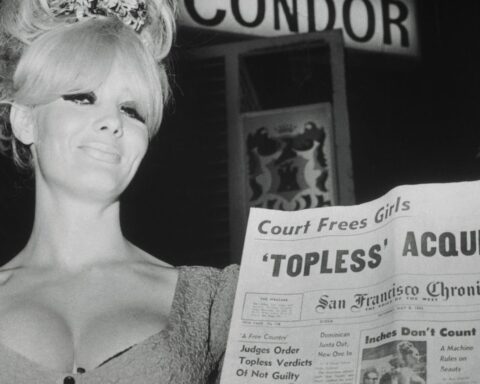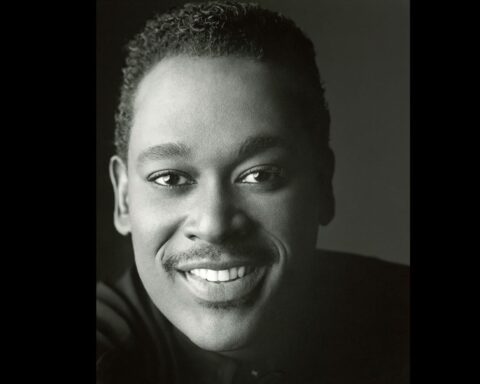Imagine someone has just handed you a plain box containing a 10,000-piece jigsaw puzzle, but with no image or description of what the finished brainteaser should look like. Then a voice, speaking from nowhere calmly says, in a British accent, “Don’t worry, sit down, and I will explain exactly how this all fits together.”
Such a seemingly impossible task is precisely what Adam Curtis’s new documentary series Can’t Get You Out of My Head has undertaken. But instead of solving a pressed cardboard conundrum, he tries to make sense of the strange world in which we exist. This epic six-part BBC series plays out over eight hours and should come with a warning: You may never look at your environment in the same way again. The title of Curtis’s latest opus is an accurate description of what to expect. Long after the final episode has ended, his conclusions on the world’s current state of affairs will grind away at you. His ideas and observations may very well bury their way into your subconsciousness, and your only reaction will be to search out more of his immaculately crafted films.
Through expertly merging stories of people and events, primarily from the latter part of the 20th Century, he shows how there was born a deep mistrust of politics and a profound suspicion of those in places of power. At the centre of Curtis’s series is the struggle between the collective and the individual, and how countries such as Russia, China, the U.S. and the UK took different paths, but all ultimately led to unsatisfying results.
This series delves deeper into similar topics he touched upon in his 2016 film, HyperNormalisation, of how banks, government, and tech companies have given up on the real world in place of creating fake ones. Both films demonstrate his sublime ability to entwine archival footage into rhythmic montages. His latest film combines disparate people of the past whose stories are told in a staggered manner. You may recognise some of them, but he also deliberately chose marginal historic figures. Through using the unfamiliar, he keeps one engaged with his narrative, rather than dismissing viewers through the act of any preconceived knowledge.
By always returning and adding more layers, relevance of these historic figures becomes clearer as Curtis repeatedly fills in spaces of information purposely omitted. This has the effect of unbalancing you, and at times, will have you questioning how the latest character will be reprised, and whether they will meet an untimely and unpleasant end like many of the individuals that populate his peculiar and hypnotic world. Add his love for modern electronic soundtracks, and one has a concept of the bizarre edits that work well, but at times, probably shouldn’t.
All the while, Curtis’s voice guides the viewer on a path that one can’t help but want to follow, desperately searching for the discarded breadcrumbs as clues to the director’s line of thought. He explains how we have ended up in a world of our doing, and how we all seem paralyzed, unable to change the current status quo because, as he claims, no one has any alternative solutions. The tech companies are in control of our wants and needs, at times before we are even aware of it. Instead of engaging in the real world, we prefer to seek comfort in conspiracy theories and deceptions in an attempt to avoid change. In the 1950s and 1960s, he explains, when we protested for change and peoples’ rights, there was a level of commitment to collective action. People lived the idea of change. Now we are interested in being seen to believe in an ideal world but are unwilling to make any sacrifices for that to happen. The rise of individualism has corroded politics.
In the first episode, we are introduced to Kerry Thornley, Greg Hill, and Operation Mindfuck, which is perhaps an alternative name for Curtis’s series. He shows how together they created the idea of discordianism. They thought humans had the power to bring order and meaning to chaos unlike the old structure of power that generated fear and suspicion. In 1969, some followers of these ideas—most notably Robert Anton Wilson—were working for Playboy magazine. Thornley and Hill managed to get a fake letter printed in one of the issues, suggesting all the recent assassinations in America were masterminded by an organization called the Illuminati. The idea was spread through hit books by Wilson and Robert Shea and a play, which was a hit in the UK. Thornley, Hill, and Shea did this to stop the idea of conspiracy theories, by simply showing how outrageous they were. (With Wilson, it was more ambiguous.) Who would believe an 18th-century organization from southern Germany were the current rulers of the world? But conspiracies began to grow in the 1970s through political mistrust brought on by Watergate and other events. By the 1990s with the advent of more powerful computers and the internet an idea like the Illuminati found its way into the data and began to be believed by a wider audience.
Thornley, while in the army, became close friends with Lee Harvey Oswald, on whom he based a novel, prior to the shooting of JFK. He chose not to believe there were any conspiracies, only coincidences. But in later life, he changed his mind and became a believer of the very thing he fought against. Curtis plays this narrative out in part one of Can’t Get You Out of My Head, weaving it in-between a story of an upper-class English man who marries a model in the 1960s. The marriage fails and he kills himself. Cut to a Black gangster-turned-activist who then reverts back to crime. Cut to China and Mao Zedong. Cut to Ethel Boole, a 19th-century Irish novelist whose book The Gadfly became a bestseller in Russia.
Curtis revels in the chaos that he generates. The story will drag the viewer in one direction, his narration will pause for a split second followed by, “But then….” These two words will send one spinning to a country thousands of miles away or an incident that took place 30 years earlier. And one will wait patiently for him to reveal the reason for this sudden deviation.
At times, Curtis’s approach can feel almost comical, like the Monty Python line: “And now for something completely different.” This may be one reason why his films have been parodied so much on YouTube, “The Loving Trap” being one such example. The opening credits claim, “This is the story about the rise of collageumentary…and how the medium swamped the message.” If people are prepared to spend time imitating an artist’s distinct style in an attempt to get likes and comments on their social media accounts, then I suspect the artist in question has landed on a winning formula.
Curtis doesn’t see himself as a documentary filmmaker but rather a political journalist with no real political beliefs. He’s worked almost exclusively for the BBC his entire career. He started in the 1980s on a weekly programme called That’s Life, a show that managed to combine light entertainment with serious, sometimes heart-breaking, stories. Then he worked his way into more mainstream, fly-on-the-wall shorts. In these his voice remained silent, mainly writing and directing the programs. Curtis’s early films reflected the changing fabric of Britain under the then Prime Minister Margaret Thatcher. They included stories from the life in a modern department store, to more hard-hitting reporting on poor inner city housing conditions.
Since the early 1990s, his work has relied heavily on archival footage. The BBC has one of the largest image base-archives in the world, with nearly 100 kilometres of shelves full of material. Using these resources cuts costs dramatically. The BBC may have a reputation for making high-quality productions, but it is equally notorious for using its licence-paying public money with extreme caution. It’s important to realise that for all the BBC’s shortcomings, the films Curtis makes could probably not have been produced anywhere else in the world. Apart from access to the archive, his films are released via the BBC iPlayer, the online platform that allows people in the U.K. to view live TV and an ever-changing archival back catalogue of various genres, one of them being documentary. Rather than issuing an episode a week of Can’t Get You Out of My Head on one of the mainstream channels, all six were distributed at once.
The full version of the iPlayer is only legally available in the U.K. However, Curtis’ films are copied by fans onto platforms like YouTube. This occasional lack of visibility has given Adam Curtis an almost cultish following in particular with a younger generation. He’s probably more widely known in Europe than North America although his ideas are universal. With crises coming to the fore in the U.S. and U.K. due to Trump and Brexit, his observations have struck a chord with a wide group of people. Although at times the messages can seem dystopian in his films, generally towards the end, they offer the potential for hope. Ultimately, Curtis is convinced that a new type of politics is on the horizon, one that allows the individual to be celebrated but also become a part of something bigger. He has a longing for the world to seize back control from corporations and the Internet.
Throughout Can’t Get You Out of My Head, Curtis keeps coming back to the idea of patterns. Patterns within the internet, artificial intelligence searching for patterns, and patterns within history. There’s repetitive use of dance montages from around the world, and a recurring time stamp on certain film clips starting at 10:00 am. The clock moves forward through the series. Is this another pattern? In the last episode, I started questioning the relevance of the time stamp. Was it a coincidence? Did I misunderstand something? Could this be a hidden message from the Illuminati? Or is eight hours just too long to spend in the company of Mr. Curtis and the strange world he inhabits?
Canadian audiences can stream Can’t Get You Out of My Head via Thought Maybe.














